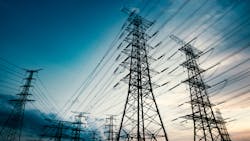The Opportunity Of A Lifetime: It’s Time To Invest In The Future Of Electrical Grid
Having successfully made its way through the U.S. Senate, President Biden’s US$1.2 trillion dollar, bi-partisan infrastructure seems certain to be signed into law. Soon, US$73 billion will be allocated to modernize the country’s electrical grid--a necessary investment that will create jobs, help mitigate climate change and ensure the American economy remains competitive throughout this century.
The funding couldn’t come at a better time. Explosive growth in demand, increasingly distributed and decentralized power generation, the rise of electric vehicles and more frequent extreme weather events have brought radical change to the industry over the past decade. Power utilities have evolved into energy service providers that deliver power across increasingly complex, dynamic electrical grids that act like living, breathing networks.
Unfortunately, today’s grid was built for yesterday’s reality and is not designed to meet all the new challenges we face. We need to use the US$73 billion infusion from the federal government to build a more connected, flexible, resilient electrical grid that meets the needs of the 21st Century.
We need to spend wisely
Change is hard, but it’s easier when there is US$73 billion in funding available from the federal government to help mitigate growing pains. In addition to direct investment, the money will backstop private investments in the grid through loan guarantees and fund much-needed research and development to improve grid flexibility. We also need to use this momentum to cut red tape, deliver innovative solutions for both existing and emerging problems and protect our grids from fast-evolving threats. Only then can we achieve an energy future built around producing, managing and delivering clean, renewable electricity.
Here are four priorities for where we believe electrical grid investments could have the greatest impact:
1. It’s time to build and upgrade transmission
We need additional transmission infrastructure to support the integration of remote, renewable energy sources onto the grid, address the rise of electric transportation, accommodate the retirement of existing power plants and facilitate sharing of energy between regions. We need an interstate planning and siting environment where long-term national interest translates into support for critical infrastructure projects. We also have the opportunity to improve power efficiency of existing transmission corridors by deploying modern technologies that can increase the capacity and performance of existing lines.
The establishment of the DOE’s new Grid Deployment Authority (GDA) promises to help reduce the bottlenecks currently associated with permitting, environmental impact studies and other regulatory requirements. Streamlining the process would ensure we’re spending taxpayer money wisely, encourage more private investment and accelerate grid modernization. As always, regional transmission investment by utilities to expand capacity and increase reliability should continue, especially in areas where new energy sources will be connecting to areas with the greatest population densities and oldest infrastructure.
2. Grid modernization for flexibility and resilience:
Funding within the infrastructure bill will be made available to deploy more digital technologies to ensure grid resilience by anticipating, sensing and mitigating disruptive events. Investments in innovations to address wildfires, storm response and vegetation management can help the industry reduce the impact of these events.
To accomplish this, the grid must be equipped with digital technologies and advanced communications that can provide increased reliability and resiliency, while managing new and dynamic supply and demand profiles. This bill has the potential to overcome understandable hesitancy in the industry and speed the adoption of newer technologies through the development of grid modernization plans approved by state utility commissions.
3. Embracing energy storage
Energy storage will be key to building the future, more resilient grid. Unused electricity should either be stored or shifted to another region where it is needed rather than curtailed or shed. While many storage concepts are being explored, the clear winner will be batteries. While the bill includes funding for battery material processing manufacturing and recycling — a very positive step — we need to go further and foster public-private partnerships (PPPs) to encourage additional R&D and create innovative IT/OT solutions for applying this energy to benefit the grid and ultimately customers.
Incentive programs, such as investment tax credits and clear recovery rules for deployment of battery storage systems for utilities would also be invaluable.
4. Keeping security at the top of the list
The grid is becoming ever more critical as the mission to net zero demands electrification at a previously unimagined scale. As we’ve seen recently, energy infrastructure is a major target for cybercriminals and nation-state actors targeting the U.S. We need to invest in cybersecurity solutions for electric grids that build upon the strong foundation already in place. Government must continue to tap into the experience of the private sector, including critical supply chain partners, as new regulations are rolled out to ensure a workable balance between security and commerce.
Once in a lifetime opportunity
We may never get another chance to make the necessary changes to our industry. Given the speed of the energy transition, it is time to partner up, get creative and move quickly to use this funding to accelerate progress. We need to enhance and expand transmission, invest in grid reliability and resiliency, create incentives and clear rules for deployment of storage and protect our most critical infrastructure incentivizing investments in cybersecurity.
About the Author
Bart Gaskey
Bart Gaskey is the senior vice-president of strategic market development at Hitachi ABB Power Grids North America.
